TUT Environmental Management: Edendale Lead Mine Hydraulic Study
VerifiedAdded on 2023/04/22
|135
|26476
|261
Thesis and Dissertation
AI Summary
This dissertation, submitted in partial fulfillment of the requirements for a Magister Technologiae degree in Environmental Management at Tshwane University of Technology, investigates the hydraulic parameters of the abandoned Edendale Lead Mine. The study employs tracer tests and stratification analysis to understand hydrodynamic processes and assess mine water quality. Water samples were collected and analyzed for various parameters, including pH, redox potential, and ion concentrations. The research aims to identify potential mine water pollution and classify water quality, with findings indicating mineralisation and possible contamination. The tracer test revealed that the flow is adjective, but the results obtained so far show that there will be not deteriorating contamination of the receiving watercourses. The study provides valuable insights into mine water management and the environmental impact of abandoned mines.
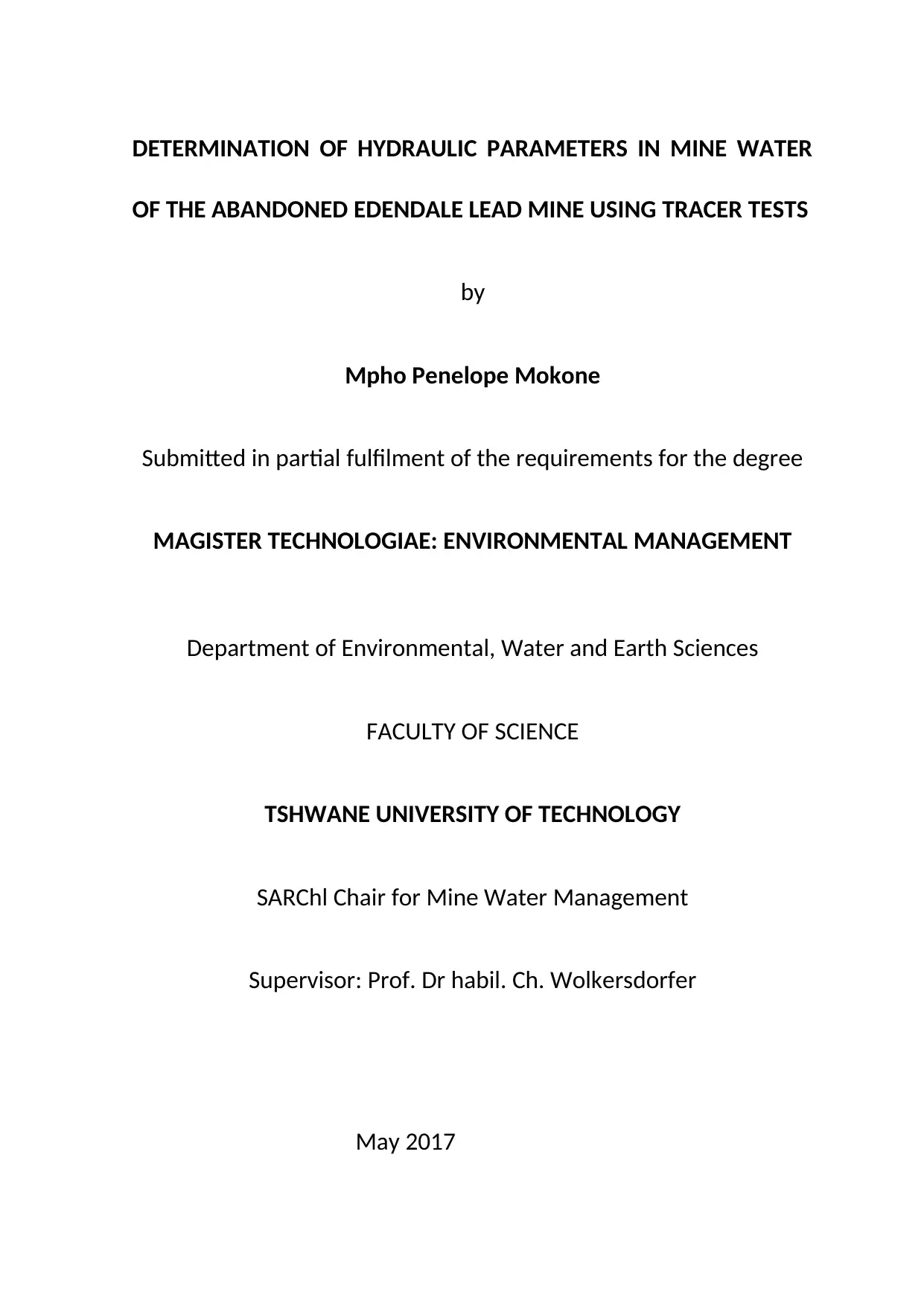
DETERMINATION OF HYDRAULIC PARAMETERS IN MINE WATER
OF THE ABANDONED EDENDALE LEAD MINE USING TRACER TESTS
by
Mpho Penelope Mokone
Submitted in partial fulfilment of the requirements for the degree
MAGISTER TECHNOLOGIAE: ENVIRONMENTAL MANAGEMENT
Department of Environmental, Water and Earth Sciences
FACULTY OF SCIENCE
TSHWANE UNIVERSITY OF TECHNOLOGY
SARChl Chair for Mine Water Management
Supervisor: Prof. Dr habil. Ch. Wolkersdorfer
May 2017
OF THE ABANDONED EDENDALE LEAD MINE USING TRACER TESTS
by
Mpho Penelope Mokone
Submitted in partial fulfilment of the requirements for the degree
MAGISTER TECHNOLOGIAE: ENVIRONMENTAL MANAGEMENT
Department of Environmental, Water and Earth Sciences
FACULTY OF SCIENCE
TSHWANE UNIVERSITY OF TECHNOLOGY
SARChl Chair for Mine Water Management
Supervisor: Prof. Dr habil. Ch. Wolkersdorfer
May 2017
Paraphrase This Document
Need a fresh take? Get an instant paraphrase of this document with our AI Paraphraser
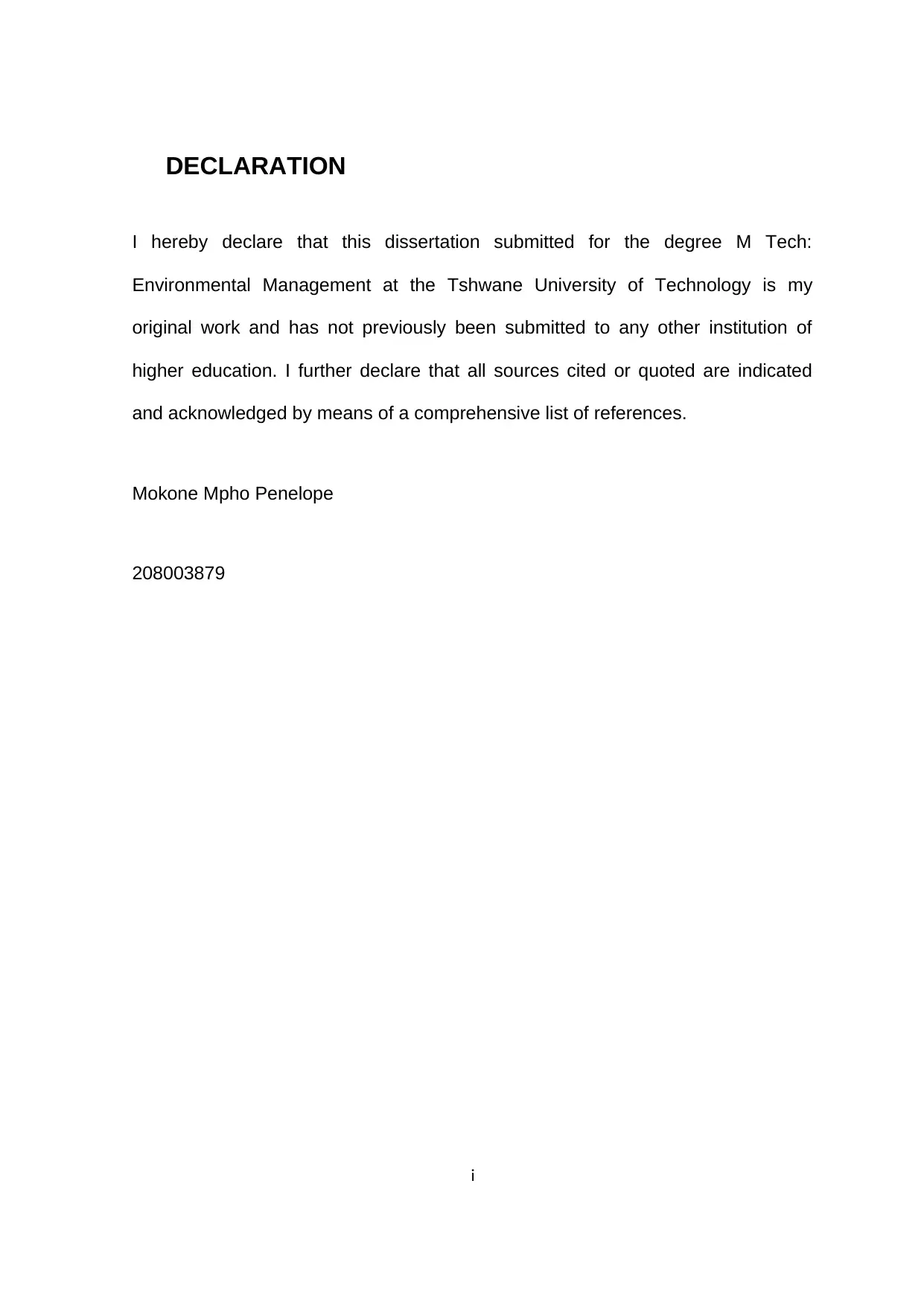
DECLARATION
I hereby declare that this dissertation submitted for the degree M Tech:
Environmental Management at the Tshwane University of Technology is my
original work and has not previously been submitted to any other institution of
higher education. I further declare that all sources cited or quoted are indicated
and acknowledged by means of a comprehensive list of references.
Mokone Mpho Penelope
208003879
i
I hereby declare that this dissertation submitted for the degree M Tech:
Environmental Management at the Tshwane University of Technology is my
original work and has not previously been submitted to any other institution of
higher education. I further declare that all sources cited or quoted are indicated
and acknowledged by means of a comprehensive list of references.
Mokone Mpho Penelope
208003879
i

Copyright © Tshwane University of Technology 2017
ii
ii
⊘ This is a preview!⊘
Do you want full access?
Subscribe today to unlock all pages.

Trusted by 1+ million students worldwide

ACKNOWLEDGMENTS
I would like to express my gratitude to my supervisor Professor Christian
Wolkersdorfer, for granting me the opportunity to study my MTech degree under
his supervision and guidance. I would like to thank him for his endless
encouragement and assistance in the field, for his valuable time that he gave for
all our discussions and all the lessons he gave for presentations and tips and
tricks of writing. I am thankful for his patience and for believing in me. It was
indeed a great privilege to work with him and I am thankful for all the time he spent
with me through to the completion of this dissertation. It would certainly be an
honour to work with him in the future.
Special thanks to Mr Thando Majodina, Geology Lecturer at the Tshwane
University of Technology for his assistance and time. To my fellow M-tech mates
who have become my second family, Lwazi, Busisiwe, and Kagiso; I appreciate
their assistance in the field and encouragement in the office all their support.
iii
I would like to express my gratitude to my supervisor Professor Christian
Wolkersdorfer, for granting me the opportunity to study my MTech degree under
his supervision and guidance. I would like to thank him for his endless
encouragement and assistance in the field, for his valuable time that he gave for
all our discussions and all the lessons he gave for presentations and tips and
tricks of writing. I am thankful for his patience and for believing in me. It was
indeed a great privilege to work with him and I am thankful for all the time he spent
with me through to the completion of this dissertation. It would certainly be an
honour to work with him in the future.
Special thanks to Mr Thando Majodina, Geology Lecturer at the Tshwane
University of Technology for his assistance and time. To my fellow M-tech mates
who have become my second family, Lwazi, Busisiwe, and Kagiso; I appreciate
their assistance in the field and encouragement in the office all their support.
iii
Paraphrase This Document
Need a fresh take? Get an instant paraphrase of this document with our AI Paraphraser

PRESENTATIONS AND PUBLICATIONS
The work contained in this thesis has previously been presented at conferences as
indicated below.
Conference Presentations
Mokone, M. P. & Wolkersdorfer, C. The Determination of Hydrodynamic
Processes and Mine Water Quality at the Abandoned Edendale Lead Mine By
Stratification. Poster presentation. Tshwane University of Technology, Faculty
Research Day. 9 September 2016, Pretoria, South Africa.
Mokone, M. P. & Wolkersdorfer, C. Tracer Test in Mine Water of the Abandoned
Edendale Lead Mine, South Africa. Oral presentation. 13th International Mine
Water Association Congress. 25 – 30 June 2017, Rauha, Lappeenranta, Finland.
Publications
Mokone, M. P. & Wolkersdorfer, C. Tracer Test in Mine Water of the Abandoned
Edendale Lead Mine, South Africa. IMWA 2017 – Mine Water & Circular Economy
(Vol I), proceedings: 342-350.
iv
The work contained in this thesis has previously been presented at conferences as
indicated below.
Conference Presentations
Mokone, M. P. & Wolkersdorfer, C. The Determination of Hydrodynamic
Processes and Mine Water Quality at the Abandoned Edendale Lead Mine By
Stratification. Poster presentation. Tshwane University of Technology, Faculty
Research Day. 9 September 2016, Pretoria, South Africa.
Mokone, M. P. & Wolkersdorfer, C. Tracer Test in Mine Water of the Abandoned
Edendale Lead Mine, South Africa. Oral presentation. 13th International Mine
Water Association Congress. 25 – 30 June 2017, Rauha, Lappeenranta, Finland.
Publications
Mokone, M. P. & Wolkersdorfer, C. Tracer Test in Mine Water of the Abandoned
Edendale Lead Mine, South Africa. IMWA 2017 – Mine Water & Circular Economy
(Vol I), proceedings: 342-350.
iv
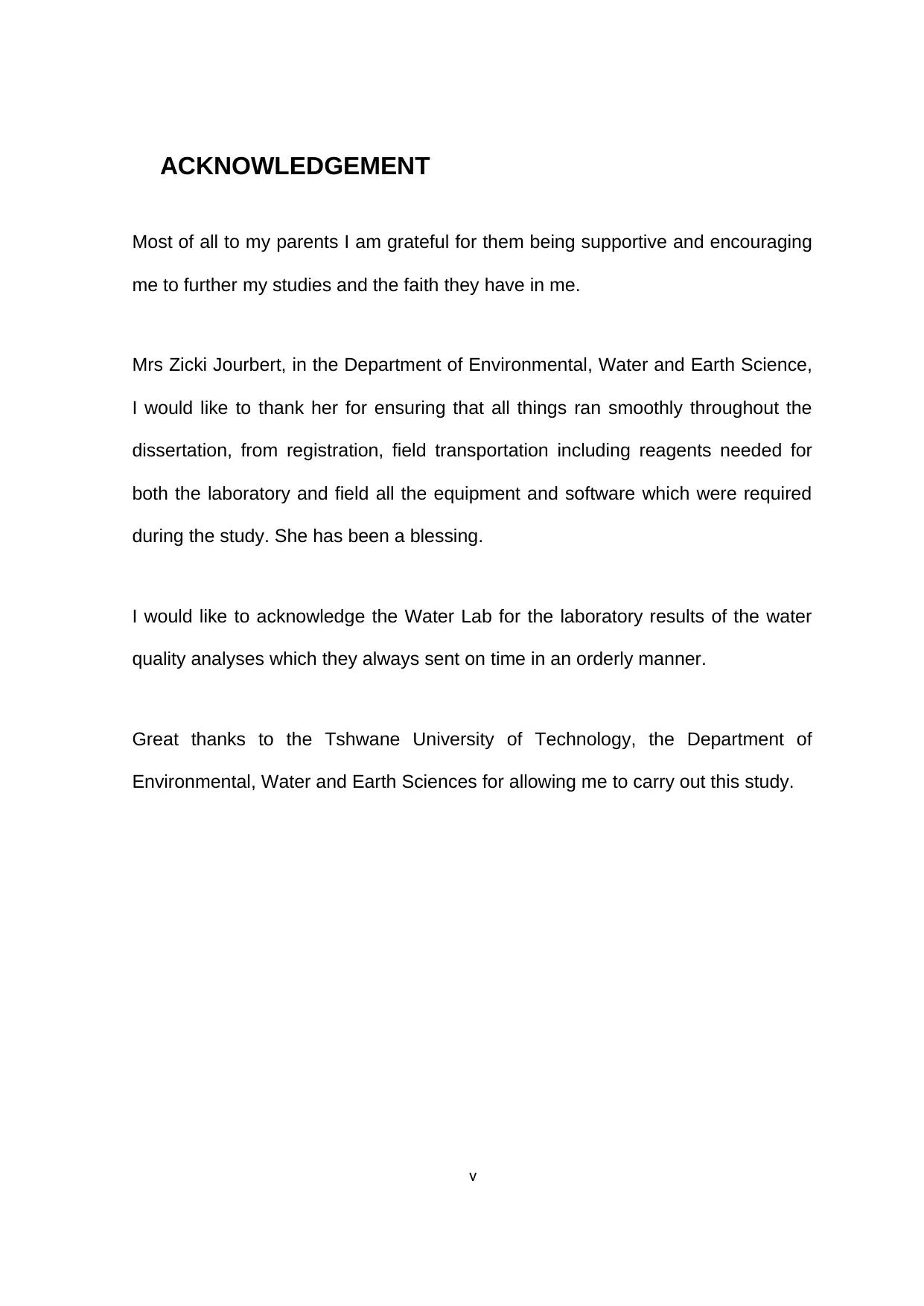
ACKNOWLEDGEMENT
Most of all to my parents I am grateful for them being supportive and encouraging
me to further my studies and the faith they have in me.
Mrs Zicki Jourbert, in the Department of Environmental, Water and Earth Science,
I would like to thank her for ensuring that all things ran smoothly throughout the
dissertation, from registration, field transportation including reagents needed for
both the laboratory and field all the equipment and software which were required
during the study. She has been a blessing.
I would like to acknowledge the Water Lab for the laboratory results of the water
quality analyses which they always sent on time in an orderly manner.
Great thanks to the Tshwane University of Technology, the Department of
Environmental, Water and Earth Sciences for allowing me to carry out this study.
v
Most of all to my parents I am grateful for them being supportive and encouraging
me to further my studies and the faith they have in me.
Mrs Zicki Jourbert, in the Department of Environmental, Water and Earth Science,
I would like to thank her for ensuring that all things ran smoothly throughout the
dissertation, from registration, field transportation including reagents needed for
both the laboratory and field all the equipment and software which were required
during the study. She has been a blessing.
I would like to acknowledge the Water Lab for the laboratory results of the water
quality analyses which they always sent on time in an orderly manner.
Great thanks to the Tshwane University of Technology, the Department of
Environmental, Water and Earth Sciences for allowing me to carry out this study.
v
⊘ This is a preview!⊘
Do you want full access?
Subscribe today to unlock all pages.

Trusted by 1+ million students worldwide
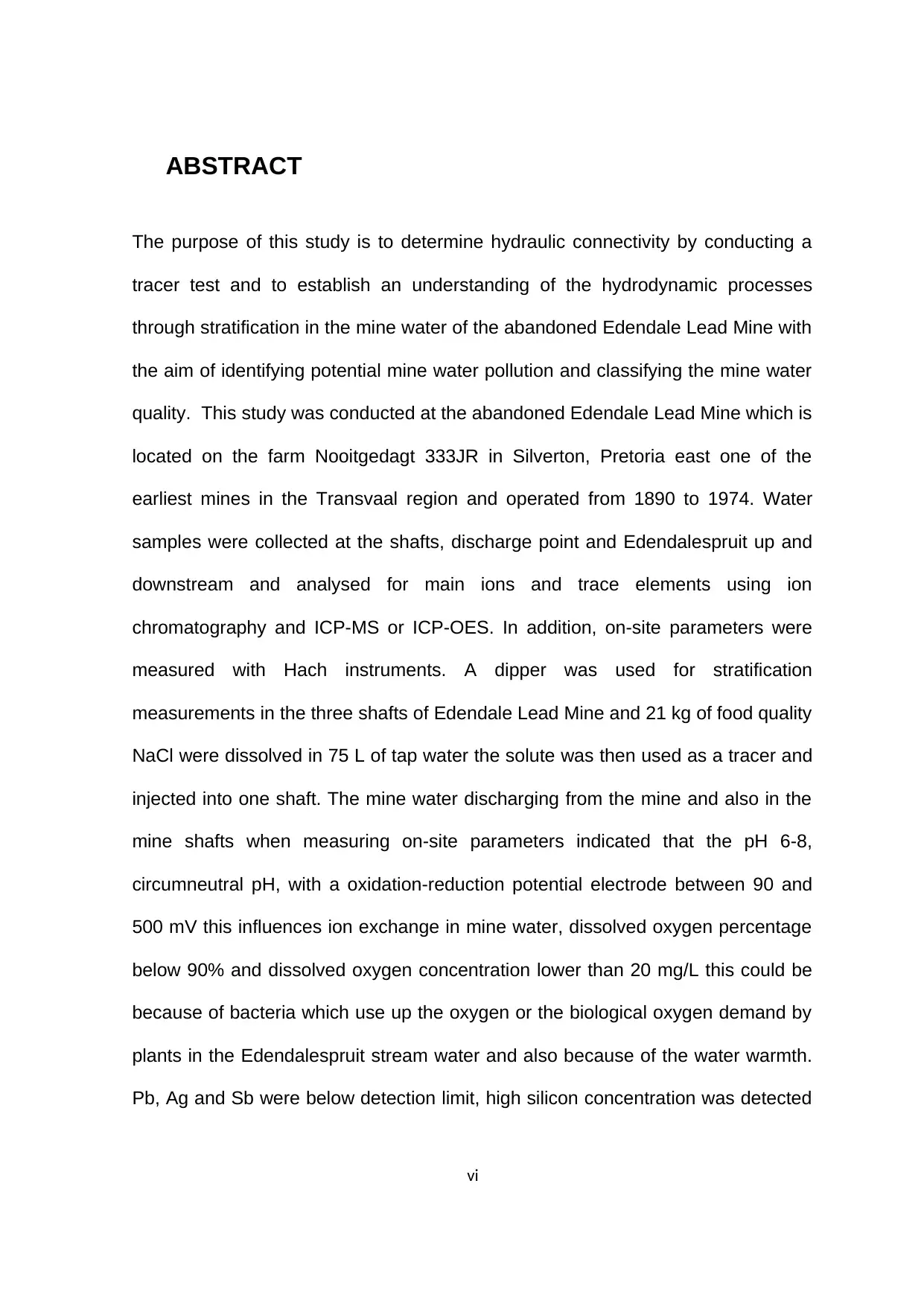
ABSTRACT
The purpose of this study is to determine hydraulic connectivity by conducting a
tracer test and to establish an understanding of the hydrodynamic processes
through stratification in the mine water of the abandoned Edendale Lead Mine with
the aim of identifying potential mine water pollution and classifying the mine water
quality. This study was conducted at the abandoned Edendale Lead Mine which is
located on the farm Nooitgedagt 333JR in Silverton, Pretoria east one of the
earliest mines in the Transvaal region and operated from 1890 to 1974. Water
samples were collected at the shafts, discharge point and Edendalespruit up and
downstream and analysed for main ions and trace elements using ion
chromatography and ICP-MS or ICP-OES. In addition, on-site parameters were
measured with Hach instruments. A dipper was used for stratification
measurements in the three shafts of Edendale Lead Mine and 21 kg of food quality
NaCl were dissolved in 75 L of tap water the solute was then used as a tracer and
injected into one shaft. The mine water discharging from the mine and also in the
mine shafts when measuring on-site parameters indicated that the pH 6-8,
circumneutral pH, with a oxidation-reduction potential electrode between 90 and
500 mV this influences ion exchange in mine water, dissolved oxygen percentage
below 90% and dissolved oxygen concentration lower than 20 mg/L this could be
because of bacteria which use up the oxygen or the biological oxygen demand by
plants in the Edendalespruit stream water and also because of the water warmth.
Pb, Ag and Sb were below detection limit, high silicon concentration was detected
vi
The purpose of this study is to determine hydraulic connectivity by conducting a
tracer test and to establish an understanding of the hydrodynamic processes
through stratification in the mine water of the abandoned Edendale Lead Mine with
the aim of identifying potential mine water pollution and classifying the mine water
quality. This study was conducted at the abandoned Edendale Lead Mine which is
located on the farm Nooitgedagt 333JR in Silverton, Pretoria east one of the
earliest mines in the Transvaal region and operated from 1890 to 1974. Water
samples were collected at the shafts, discharge point and Edendalespruit up and
downstream and analysed for main ions and trace elements using ion
chromatography and ICP-MS or ICP-OES. In addition, on-site parameters were
measured with Hach instruments. A dipper was used for stratification
measurements in the three shafts of Edendale Lead Mine and 21 kg of food quality
NaCl were dissolved in 75 L of tap water the solute was then used as a tracer and
injected into one shaft. The mine water discharging from the mine and also in the
mine shafts when measuring on-site parameters indicated that the pH 6-8,
circumneutral pH, with a oxidation-reduction potential electrode between 90 and
500 mV this influences ion exchange in mine water, dissolved oxygen percentage
below 90% and dissolved oxygen concentration lower than 20 mg/L this could be
because of bacteria which use up the oxygen or the biological oxygen demand by
plants in the Edendalespruit stream water and also because of the water warmth.
Pb, Ag and Sb were below detection limit, high silicon concentration was detected
vi
Paraphrase This Document
Need a fresh take? Get an instant paraphrase of this document with our AI Paraphraser
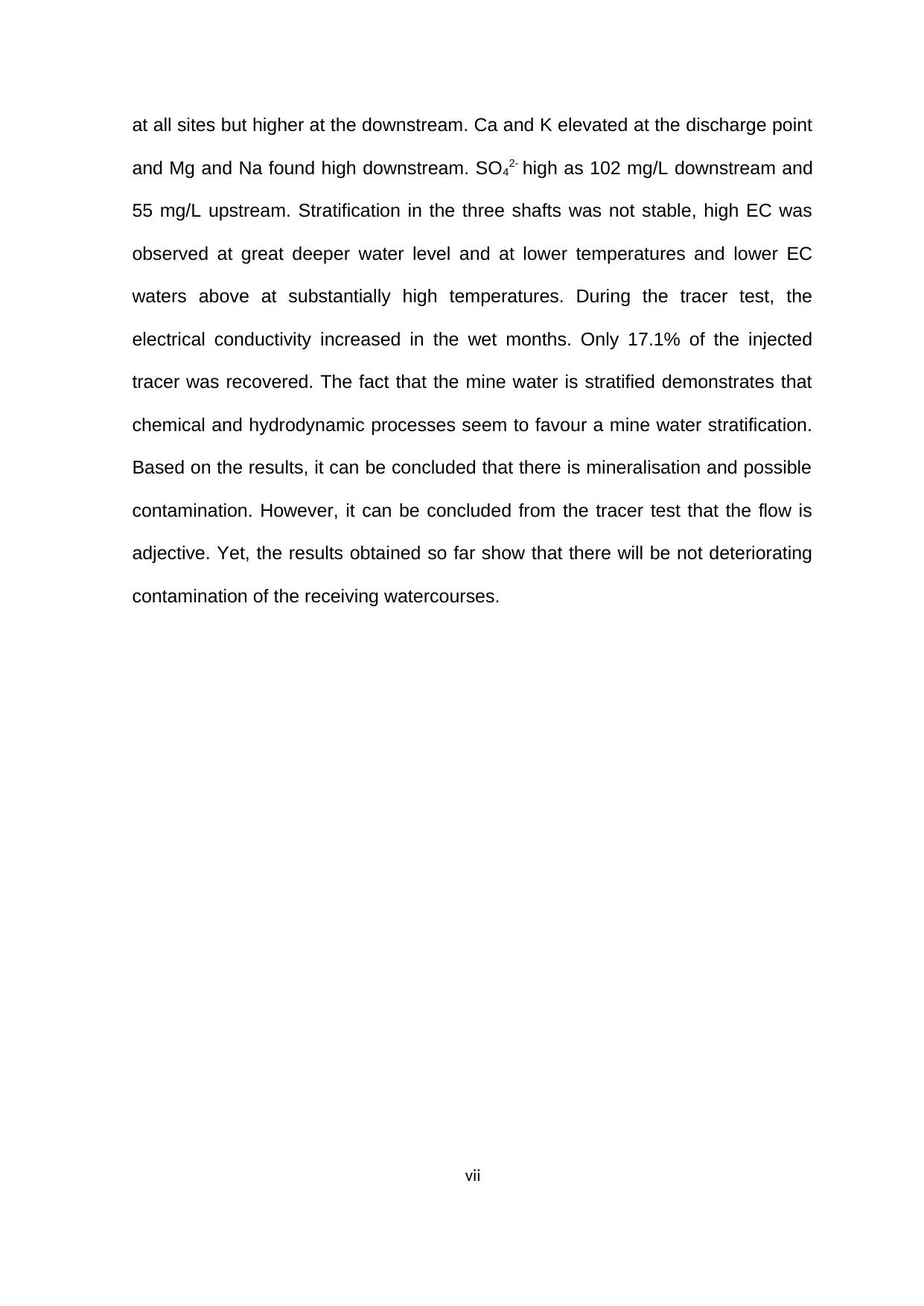
at all sites but higher at the downstream. Ca and K elevated at the discharge point
and Mg and Na found high downstream. SO42- high as 102 mg/L downstream and
55 mg/L upstream. Stratification in the three shafts was not stable, high EC was
observed at great deeper water level and at lower temperatures and lower EC
waters above at substantially high temperatures. During the tracer test, the
electrical conductivity increased in the wet months. Only 17.1% of the injected
tracer was recovered. The fact that the mine water is stratified demonstrates that
chemical and hydrodynamic processes seem to favour a mine water stratification.
Based on the results, it can be concluded that there is mineralisation and possible
contamination. However, it can be concluded from the tracer test that the flow is
adjective. Yet, the results obtained so far show that there will be not deteriorating
contamination of the receiving watercourses.
vii
and Mg and Na found high downstream. SO42- high as 102 mg/L downstream and
55 mg/L upstream. Stratification in the three shafts was not stable, high EC was
observed at great deeper water level and at lower temperatures and lower EC
waters above at substantially high temperatures. During the tracer test, the
electrical conductivity increased in the wet months. Only 17.1% of the injected
tracer was recovered. The fact that the mine water is stratified demonstrates that
chemical and hydrodynamic processes seem to favour a mine water stratification.
Based on the results, it can be concluded that there is mineralisation and possible
contamination. However, it can be concluded from the tracer test that the flow is
adjective. Yet, the results obtained so far show that there will be not deteriorating
contamination of the receiving watercourses.
vii

TABLE OF CONTENTS
PAGE
DECLARATION.....................................................................................................................................i
ACKNOWLEDGMENTS.......................................................................................................................ii
PRESENTATIONS AND PUBLICATIONS...............................................................................................iii
Conference Presentations........................................................................................................iii
Publications..............................................................................................................................iii
ACKNOWLEDGEMENT......................................................................................................................iv
ABSTRACT..........................................................................................................................................v
LIST OF FIGURES...............................................................................................................................xi
LIST OF TABLES.................................................................................................................................xv
LIST OF ABBREVIATIONS.................................................................................................................xvi
1 INTRODUCTION.........................................................................................................................1
1.1 Background And Justification............................................................................................1
1.2 Research Problem..............................................................................................................5
viii
PAGE
DECLARATION.....................................................................................................................................i
ACKNOWLEDGMENTS.......................................................................................................................ii
PRESENTATIONS AND PUBLICATIONS...............................................................................................iii
Conference Presentations........................................................................................................iii
Publications..............................................................................................................................iii
ACKNOWLEDGEMENT......................................................................................................................iv
ABSTRACT..........................................................................................................................................v
LIST OF FIGURES...............................................................................................................................xi
LIST OF TABLES.................................................................................................................................xv
LIST OF ABBREVIATIONS.................................................................................................................xvi
1 INTRODUCTION.........................................................................................................................1
1.1 Background And Justification............................................................................................1
1.2 Research Problem..............................................................................................................5
viii
⊘ This is a preview!⊘
Do you want full access?
Subscribe today to unlock all pages.

Trusted by 1+ million students worldwide
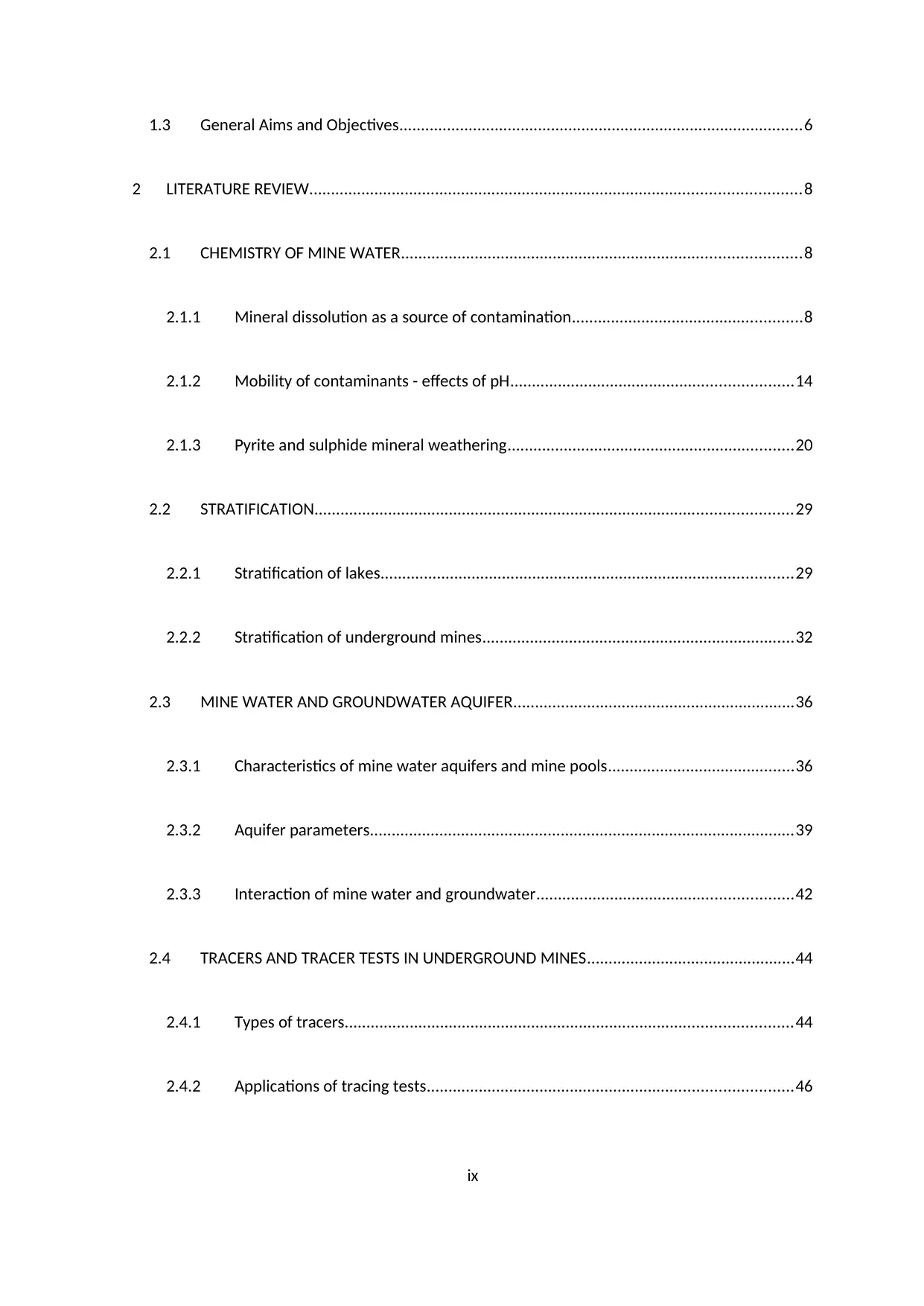
1.3 General Aims and Objectives.............................................................................................6
2 LITERATURE REVIEW.................................................................................................................8
2.1 CHEMISTRY OF MINE WATER............................................................................................8
2.1.1 Mineral dissolution as a source of contamination.....................................................8
2.1.2 Mobility of contaminants - effects of pH.................................................................14
2.1.3 Pyrite and sulphide mineral weathering..................................................................20
2.2 STRATIFICATION..............................................................................................................29
2.2.1 Stratification of lakes...............................................................................................29
2.2.2 Stratification of underground mines........................................................................32
2.3 MINE WATER AND GROUNDWATER AQUIFER.................................................................36
2.3.1 Characteristics of mine water aquifers and mine pools...........................................36
2.3.2 Aquifer parameters..................................................................................................39
2.3.3 Interaction of mine water and groundwater...........................................................42
2.4 TRACERS AND TRACER TESTS IN UNDERGROUND MINES................................................44
2.4.1 Types of tracers.......................................................................................................44
2.4.2 Applications of tracing tests....................................................................................46
ix
2 LITERATURE REVIEW.................................................................................................................8
2.1 CHEMISTRY OF MINE WATER............................................................................................8
2.1.1 Mineral dissolution as a source of contamination.....................................................8
2.1.2 Mobility of contaminants - effects of pH.................................................................14
2.1.3 Pyrite and sulphide mineral weathering..................................................................20
2.2 STRATIFICATION..............................................................................................................29
2.2.1 Stratification of lakes...............................................................................................29
2.2.2 Stratification of underground mines........................................................................32
2.3 MINE WATER AND GROUNDWATER AQUIFER.................................................................36
2.3.1 Characteristics of mine water aquifers and mine pools...........................................36
2.3.2 Aquifer parameters..................................................................................................39
2.3.3 Interaction of mine water and groundwater...........................................................42
2.4 TRACERS AND TRACER TESTS IN UNDERGROUND MINES................................................44
2.4.1 Types of tracers.......................................................................................................44
2.4.2 Applications of tracing tests....................................................................................46
ix
Paraphrase This Document
Need a fresh take? Get an instant paraphrase of this document with our AI Paraphraser
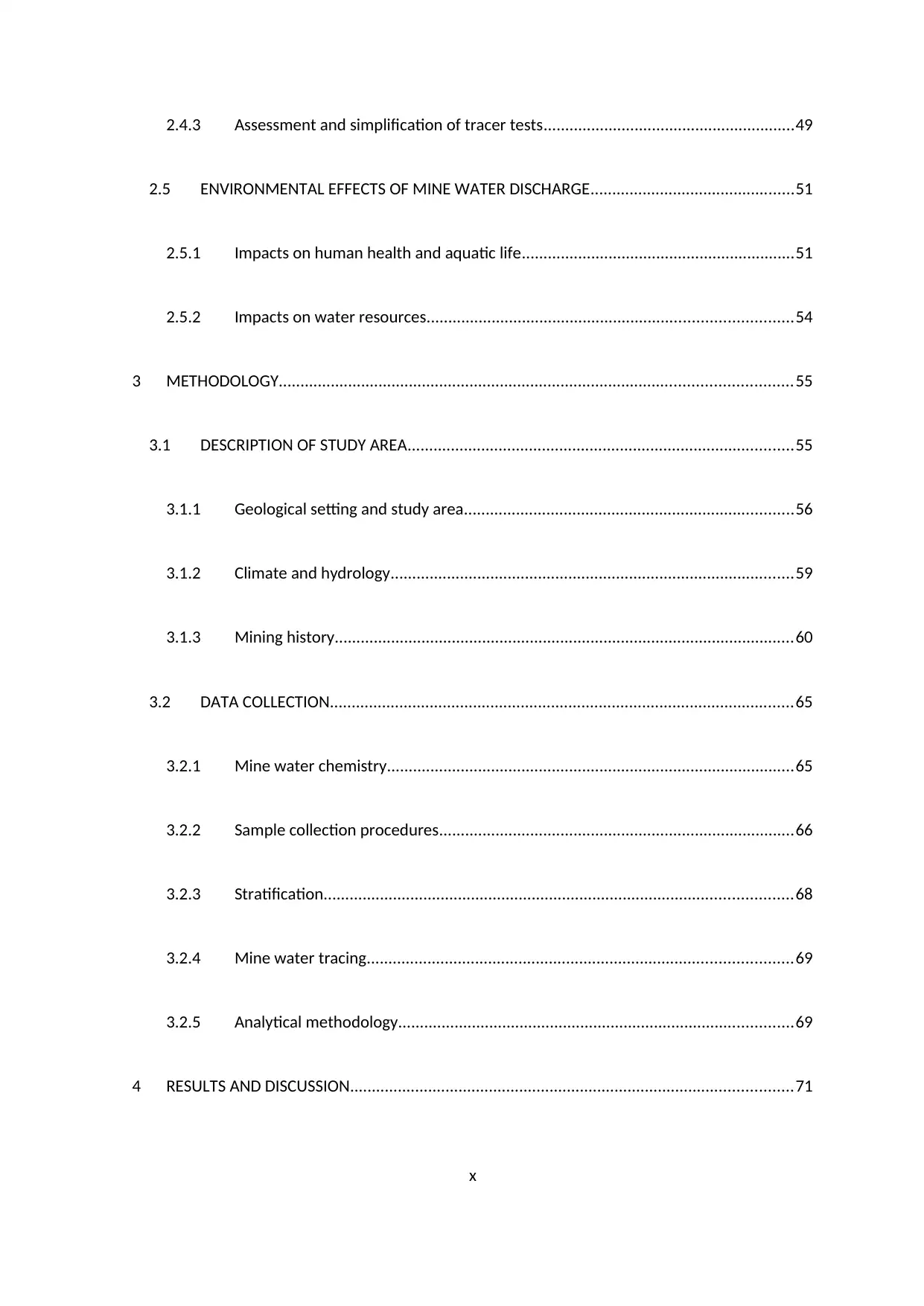
2.4.3 Assessment and simplification of tracer tests..........................................................49
2.5 ENVIRONMENTAL EFFECTS OF MINE WATER DISCHARGE...............................................51
2.5.1 Impacts on human health and aquatic life...............................................................51
2.5.2 Impacts on water resources....................................................................................54
3 METHODOLOGY......................................................................................................................55
3.1 DESCRIPTION OF STUDY AREA.........................................................................................55
3.1.1 Geological setting and study area............................................................................56
3.1.2 Climate and hydrology.............................................................................................59
3.1.3 Mining history..........................................................................................................60
3.2 DATA COLLECTION...........................................................................................................65
3.2.1 Mine water chemistry..............................................................................................65
3.2.2 Sample collection procedures..................................................................................66
3.2.3 Stratification............................................................................................................68
3.2.4 Mine water tracing..................................................................................................69
3.2.5 Analytical methodology...........................................................................................69
4 RESULTS AND DISCUSSION......................................................................................................71
x
2.5 ENVIRONMENTAL EFFECTS OF MINE WATER DISCHARGE...............................................51
2.5.1 Impacts on human health and aquatic life...............................................................51
2.5.2 Impacts on water resources....................................................................................54
3 METHODOLOGY......................................................................................................................55
3.1 DESCRIPTION OF STUDY AREA.........................................................................................55
3.1.1 Geological setting and study area............................................................................56
3.1.2 Climate and hydrology.............................................................................................59
3.1.3 Mining history..........................................................................................................60
3.2 DATA COLLECTION...........................................................................................................65
3.2.1 Mine water chemistry..............................................................................................65
3.2.2 Sample collection procedures..................................................................................66
3.2.3 Stratification............................................................................................................68
3.2.4 Mine water tracing..................................................................................................69
3.2.5 Analytical methodology...........................................................................................69
4 RESULTS AND DISCUSSION......................................................................................................71
x

4.1 Introduction.....................................................................................................................71
4.2 On-site parameters..........................................................................................................71
4.3 Water Chemistry.............................................................................................................79
4.4 Statistical Analysis...........................................................................................................83
4.5 Stratification....................................................................................................................84
4.6 Tracer test.......................................................................................................................92
5 CONCLUSION AND RECOMMENDATIONS................................................................................95
6 REFERENCES............................................................................................................................96
APPENDIX I....................................................................................................................................117
Water Samples co-ordinates.........................................................................................................118
xi
4.2 On-site parameters..........................................................................................................71
4.3 Water Chemistry.............................................................................................................79
4.4 Statistical Analysis...........................................................................................................83
4.5 Stratification....................................................................................................................84
4.6 Tracer test.......................................................................................................................92
5 CONCLUSION AND RECOMMENDATIONS................................................................................95
6 REFERENCES............................................................................................................................96
APPENDIX I....................................................................................................................................117
Water Samples co-ordinates.........................................................................................................118
xi
⊘ This is a preview!⊘
Do you want full access?
Subscribe today to unlock all pages.

Trusted by 1+ million students worldwide
1 out of 135
Related Documents
Your All-in-One AI-Powered Toolkit for Academic Success.
+13062052269
info@desklib.com
Available 24*7 on WhatsApp / Email
![[object Object]](/_next/static/media/star-bottom.7253800d.svg)
Unlock your academic potential
Copyright © 2020–2025 A2Z Services. All Rights Reserved. Developed and managed by ZUCOL.





